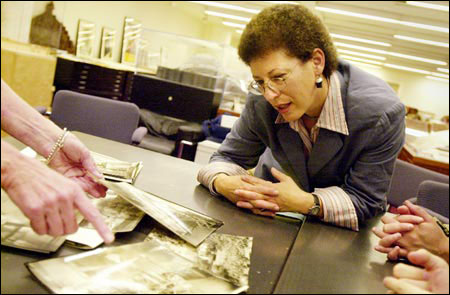Probing the built environment
Interdisciplinary seminar constructs special rewards

History graduate student Ben Waterhouse is working on a research paper about the building of Boston’s Prudential Center in the early 1960s. He plans to examine the influence of corporations in bringing the massive building project to fruition and the reaction of ordinary people to that corporate influence.
In a conventional graduate seminar, Waterhouse might carry out this project under the guidance of a single professor with additional advice and criticism from fellow students. But the seminar in which Waterhouse is conducting his research is far from ordinary.
Waterhouse is one of 11 graduate students in a seminar called “The Culture and Politics of the Built Environment in the U.S.,” co-taught by Lizabeth Cohen, the Howard Mumford Jones Professor of American Studies and director of the Charles Warren Center for Studies in American History, and Margaret Crawford, professor of urban design and planning theory at the Harvard Graduate School of Design (GSD). The seminar includes students from the History Department, the History of Art and Architecture, the GSD’s Ph.D. program, and the Divinity School.
Not only do participants in the seminar have the advantage of bouncing their ideas off a highly diverse group of students and professors, they also have the opportunity to explore topics on a level to which graduate students ordinarily have limited access. This opportunity results from the fact that the seminar is being taught in conjunction with a workshop that brings together a group of nine highly diverse scholars in fields related to the built environment, all of them 2004-05 Warren Center fellows.
Waterhouse, who took the seminar last year when its focus was the nexus between history and economics, described the impact of sitting in on discussions of advanced scholars at a time when he himself was just beginning graduate study.
“It was very intimidating at first. I remember that in the first session with the Warren Center fellows, I felt overwhelmed. I could barely follow the conversation. But later on in the semester I began to realize how much I had absorbed. I had begun to think like a historian.”
Waterhouse said that this year, the program is even more stimulating because it brings together people who are focusing on the same subjects from very different perspectives.
“It’s even more interdisciplinary. People from a design background approach things from a very different viewpoint and ask very different questions,” he said.
Lara Belkind, a Ph.D. student in the GSD studying urban planning, agrees.
“Bringing together historians and people with design backgrounds lends more complexity to the way we see the built environment. We come to the subject with different assumptions, and I think it helps all of us to be more critical and more aware of the assumptions we make.”
Belkind, who has worked as an urban planner in New York City and has studied working-class neighborhoods in Paris on a Fulbright scholarship, said that she is impressed by the diversity of topics covered by the papers that the Warren Center fellows present every two weeks – everything from landscape change in 19th century New England to highway construction in Los Angeles and its impact on race.
For Cohen and Crawford, the seminar’s theme not only lends itself to an interdisciplinary approach, but it also reflects an interest in material culture and in the experience of ordinary individuals that has increasingly engaged historians in recent years.
“The interest in the built environment comes out of a revolution in social history in which we’re no longer just looking at the leaders of society, but rather at the way ordinary people experience their world,” Cohen said. “In this seminar, we’re interested in how people experience space and how they change space.”
Cohen, the author of “A Consumers’ Republic: The Politics of Mass Consumption in Postwar America” (2003), has long had an interest in material culture and the impact of the built environment on people’s lives. This spring, she will teach an undergraduate seminar called “Building Boston in the 19th and 20th Centuries,” an exploration of the built environment in Boston with particular attention to the interaction of architects and builders, economic and political interests, and ordinary residents, and ending with a look at the Big Dig and Harvard’s expansion into Allston.
Crawford is the author of “Building the Workingman’s Paradise: The Design of American Company Towns” (1995), as well as articles on World War II housing, race and gender, and the history of Los Angeles. She has also studied the use of public space by street vendors and other unlicensed entrepreneurs in Los Angeles (“Everyday Urbanism,” 1999, co-edited with John Chase and John Kaliski), and is currently teaching a GSD course called “Listening to the City,” in which students explore complex urban dynamics exemplified by Chelsea, Mass.
She said of the Warren Center seminar: “It’s my dream come true to have all these scholars talking about their projects, and for the students it’s an amazing opportunity.”
Crawford said that so far she has found the sessions in which the Warren Center fellows present their research papers to be extremely stimulating for everyone concerned.
“I’ve been thrilled by the range of questions. People come at the topic from every conceivable point of view. It’s been very exciting.”




